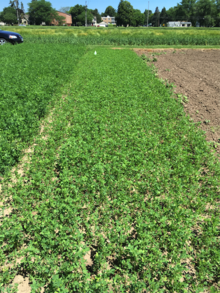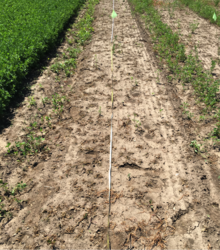What you need to know
Allow at least one year between terminating an old alfalfa stand and re-seeding alfalfa.
Delaying reseeding two to four weeks following termination of an injured stand is still risky to establishment and yield.
Don’t thicken thinning stands of alfalfa with alfalfa.
Rotate from alfalfa to a grass crop to use residual alfalfa nitrogen.
Alfalfa autotoxicity occurs when a mature alfalfa plant excretes a chemical that inhibits the germination and growth of seeded alfalfa.
Although several factors influence autotoxicity -- such as soil texture, rainfall and termination timing -- research indicates the need for a break in the production and/or crop rotation to avoid potential stand establishment problems.
Autotoxicity in alfalfa isn’t a common issue, given the typical crop rotation where corn follows alfalfa. However, there are situations - such as a failed seeding or extensive winter injury - where assessing the risk of autotoxicity would be helpful.
Alfalfa autotoxicity demonstration
Overview
To demonstrate the extremes (i.e., no planting delay), two-year-old alfalfa was flail-mowed and the residue incorporated. After incorporation, alfalfa was Brillion-seeded into a well-prepared seedbed at 12 pounds per acre.
Because the chemicals associated with autotoxicity are thought to concentrate in the leaf material, a second treatment assessed the impact of incorporating only roots on alfalfa autotoxicity.
Finally, alfalfa was seeded where there was no previous alfalfa crop, the control treatment. This enabled researchers to compare potential alfalfa autotoxicity from full plants or roots-only with the control to demonstrate how autotoxicity affects seedling establishment.
Results
The most striking difference was between the autotoxicity treatments (e.g., full plant and roots-only) and the non-autotoxicity alfalfa control plot. Autotoxicity drastically reduced alfalfa populations:
Control plots (no autotoxicity): More than 35 plants per square foot (Figure 1).
Full-plant incorporation treatment: 0.3 plants per square foot (Figure 2)
Roots-only incorporation treatment: 1.7 plants per square foot (Figure 3).
For both autotoxicity treatments, the entire plot (200 square feet) was counted. To maximize yields, growers need at least 25 plants per square foot at the onset of the first production year. Because all treatments were direct-seeded (i.e., Brillion) into well-prepared soil at 12 pounds per acre, we would expect stands greater than 25 plants per square foot.
Source: Demonstration photos are from the Institute for Agricultural Professional Field School plots on the University of Minnesota St. Paul campus.
What this means for producers
In most years, it's doubtful alfalfa growers will face with such extreme scenarios. We created an extreme example to force the issue to demonstrate the potential risks. The severity of stand loss and probability of encountering autotoxicity when seeding into existing alfalfa likely would be less than shown here, but the potential for problems is real with significant risk of stand loss and incurred costs.
In years with significant winterkill, consider autotoxicity in alfalfa and be ready to rotate to a non-alfalfa crop: Emergency forages: Warm-season crops and Winterkilled alfalfa.
Management recommendations
We recommend the following management guidelines for reducing the risk of alfalfa autotoxicity.
Allow at least one year between terminating an old alfalfa stand and reseeding alfalfa. Although we were able to effectively establish alfalfa within a shorter window, evidence of autotoxicity suggests a longer rotation interval may be better.
Seed killed alfalfa stands to another crop in spring.
Delaying spring seeding of alfalfa following winterkill involves risk on some soils. Delaying spring reseeding two to four weeks after tilling a killed stand is not an effective strategy to alleviate autotoxicity. Delayed seeding can result in significant yield losses during the reseeding year.
Don’t thicken alfalfa with alfalfa. When considering overall risk associated with alfalfa autotoxicity, it’s less risky to not thicken thinning stands of alfalfa with alfalfa.
Plant corn or another grass crop that is not affected by alfalfa allelochemicals and that can use the residual nitrogen from alfalfa production.
Reviewed in 2023




